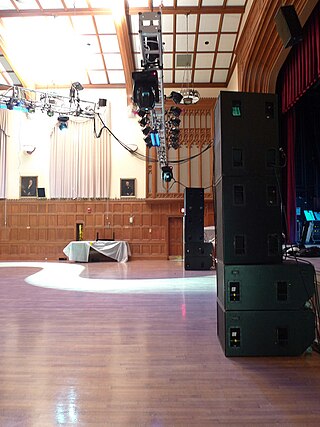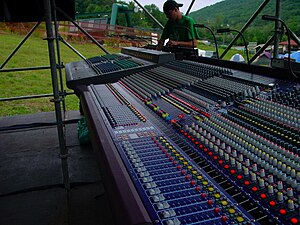
A mixing console or mixing desk is an electronic device for mixing audio signals, used in sound recording and reproduction and sound reinforcement systems. Inputs to the console include microphones, signals from electric or electronic instruments, or recorded sounds. Mixers may control analog or digital signals. The modified signals are summed to produce the combined output signals, which can then be broadcast, amplified through a sound reinforcement system or recorded.

A preamplifier, also known as a preamp, is an electronic amplifier that converts a weak electrical signal into an output signal strong enough to be noise-tolerant and strong enough for further processing, or for sending to a power amplifier and a loudspeaker. Without this, the final signal would be noisy or distorted. They are typically used to amplify signals from analog sensors such as microphones and pickups. Because of this, the preamplifier is often placed close to the sensor to reduce the effects of noise and interference.
Open Sound Control (OSC) is a protocol for networking sound synthesizers, computers, and other multimedia devices for purposes such as musical performance or show control. OSC's advantages include interoperability, accuracy, flexibility and enhanced organization and documentation. Its disadvantages include inefficient coding of information, increased load on embedded processors, and lack of standardized messages/interoperability. The first specification was released in March 2002.

A stage box is an interface device used in sound reinforcement and recording studios to connect equipment to a mixing console. It provides a central location to connect microphones, instruments, and speakers to a multicore cable (snake), which allows the sound desk to be further from the stage and simplifies setup.
Solid State Logic Ltd. (SSL) is a British company based in Begbroke, Oxfordshire, England that designs and markets audio mixing consoles, signal processors, and other audio technologies for the post-production, video production, broadcast, sound reinforcement and music recording industries. SSL employs over 160 people worldwide and has regional offices in Los Angeles, Milan, New York City, Paris, and Tokyo, with additional support provided by an international network of distributors. Solid State Logic is part of the Audiotonix Group.

AMS Neve Ltd is a privately owned audio engineering company who specialise in digital and analogue music consoles, outboard equipment and post production consoles. AMS Neve was the result of the amalgamation in 1992 of AMS with Neve Electronics.
In audio and broadcast engineering, audio over Ethernet (AoE) is the use of an Ethernet-based network to distribute real-time digital audio. AoE replaces bulky snake cables or audio-specific installed low-voltage wiring with standard network structured cabling in a facility. AoE provides a reliable backbone for any audio application, such as for large-scale sound reinforcement in stadiums, airports and convention centers, multiple studios or stages.
Harrison Audio Consoles is an international company based in Nashville, Tennessee that manufactures high-end mixing consoles, Digital Audio Workstations (DAW), audio plugins, and other audio technologies for the post-production, video production, broadcast, sound reinforcement and music recording industries. The company is renowned as an industry innovation for its "in-line" mixing console design that has subsequently become the standard for nearly every large-format music console. Over 1,500 Harrison consoles have been installed worldwide, presenting a significant percentage of the overall world market share for high-end audio consoles. The company founder, Dave Harrison, was inducted as a Fellow in the Audio Engineering Society for this technical contribution of the recording industry and in particular the first 32-bus "in-line" console.
LOUD Audio, LLC is a professional audio company based in the United States, operating in the U.S., Canada, and Shenzhen, China. Originally founded as Mackie Designs, Inc., the name was changed to Loud Technologies Inc in 2003 to differentiate its founding subsidiary, mixing console manufacturer Mackie from its eponymous brand name.

In professional audio, a digital mixing console (DMC) is a type of mixing console used to combine, route, and change the dynamics, equalization and other properties of multiple audio input signals, using digital signal processing rather than analog circuitry. The digital audio samples, which is the internal representation of the analog inputs, are summed to what is known as a master channel to produce a combined output. A professional digital mixing console is a dedicated desk or control surface produced exclusively for the task and is typically more robust in terms of user control, processing power and quality of audio effects. However, a computer can also perform the same function since it can mimic its interface, input and output.
CobraNet is a combination of software, hardware, and network protocols designed to deliver uncompressed, multi-channel, low-latency digital audio over a standard Ethernet network. Developed in the 1990s, CobraNet is widely regarded as the first commercially successful audio-over-Ethernet implementation.

Yamaha Pro Audio, Inc. is the Pro Audio Division division of Yamaha Corporation that offers a complete line of beginner professional audio products for the live sound and sound reinforcement markets. Their lineup includes a number of world-standard mixing consoles, signal processors incorporating industry-leading DSP technology, power amplifiers based on energy-efficient drive technology, and an extensive range of speakers used for live sound or commercial installations. It has a long history of introducing significant products for the professional audio market such as the PM-1000 modular mixing console, the REV1 and SPX90 digital signal processors, the NS-10 studio monitors, and the 01v, 02R, 03D, PM1D, PM5D, QL5, M7CL, CL5, and PM10/7 Rivage digital mixing consoles.
Klark Teknik is a company that designs and develops professional signal processing and audio equipment. Located in Kidderminster, Worcestershire, UK, the company was founded in 1974 by brothers Terence and Phillip Clarke. It developed a number of new types of equipment in the audio field, winning a Queen's Awards for Enterprise in 1986. It is now owned by Music Tribe.
Audient Ltd. is a British company based in Herriard, Hampshire, England that designs, manufactures, and markets mixing consoles, audio interfaces, microphone preamplifiers, monitor controllers and signal processors.

Music Tribe, formerly Music Group, is a holding company based in the City of Makati, Metro Manila, Philippines. It is chaired by Uli Behringer, founder of Behringer. Music Tribe's portfolio includes Behringer, Cool Audio, Midas, Turbosound, TC Electronic and TC-Helicon, Tannoy, Klark Teknik, Lab.gruppen, and Aston Microphones.
Peter Watts is a designer of pro audio equipment who is recognized as a leader in his field.

A matrix mixer is an audio electronics device that routes multiple input audio signals to multiple outputs. It usually employs level controls such as potentiometers to determine how much of each input is going to each output, and it can incorporate simple on/off assignment buttons. The number of individual controls is at least the number of inputs multiplied by the number of outputs.

A professional audio store is a retail business that sells, and in many cases rents, sound reinforcement system equipment and PA system components used in music concerts, live shows, dance parties and speaking events. This equipment typically includes microphones, power amplifiers, electronic effects units, speaker enclosures, monitor speakers, subwoofers and audio consoles (mixers). Some professional audio stores also sell sound recording equipment, DJ equipment, lighting equipment used in nightclubs and concerts and video equipment used in events, such as video projectors and screens. Some professional audio stores rent "backline" equipment used in rock and pop shows, such as stage pianos and bass amplifiers. While professional audio stores typically focus on selling new merchandise, some stores also sell used equipment, which is often the equipment that the company has previously rented out for shows and events.

An audio interface is a piece of computer hardware that allows the input and output of audio signals to and from a host computer or recording device.
AES50 is an Audio over Ethernet protocol for multichannel digital audio. It is defined in the AES50-2011 standard for High-resolution multi-channel audio interconnection (HRMAI).











